
Before reading this post it is best to go to this link and read the over-all article on aquarium lighting:
14.4. Aquarium Lighting
Aquarium lights are used to illuminate the aquarium fish. What few recognize is that the intensity of a fish’s color is determined to a strong degree by the lights over the aquarium. To illustrate this, it is necessary to put up the spectrum of most lights and their effect on aquarium fish colors.
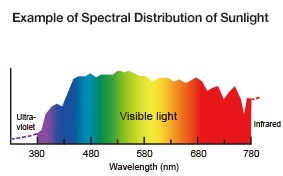
This is the spectrum of sunlight. The effect on colors is:
| Item | Effect on color seen or photographed |
| Electric blue fryeri | good |
| Green Plants | bright |
| Yellow Labidochromis | bright |
| Orange Goldfish | bright |
| Dragon Blood Peacock | bright |
This is what our eyes are accustomed to and where photography is the easiest. It is unfortunately difficult to create in the aquarium.
.
.

This is the spectrum of a typical fluorescent tube. The effect on colors is:
| Item | Effect on color seen or photographed |
| Electric blue fryeri | good |
| Green Plants | decent |
| Yellow Labidochromis | dull |
| Orange Goldfish | good |
| Dragon Blood Peacock | good |
This was what we used to use for aquariums. It did a very good job on pretty much all levels (save the yellows). Unfortunately the technology has all gone over to LEDs. This has obsoleted the fluorescent lights.
.
Cheap Shop Light Spectra

This is the spectrum of an LED bulb typically used in a house or shop. The effect on colors is:
| Item | Effect on color seen or photographed |
| Electric blue fryeri | dull |
| Green Plants | bright |
| Yellow Labidochromis | bright |
| Orange Goldfish | good |
| Dragon Blood Peacock | dull |
This is decidedly not the best lamp to use for plants (plants require blue and red-light spectra). This is also the spectral curve of the inexpensive aquarium LED fixtures with only white light elements.
An interesting combo is to combine a cheap in-home LED bulb rack as 70% to 80% of the light with a small grow light LED as 20% to 30% of the light. This should give very close to a sunlight spectrum and bright on all the items.
.
One Popular Aquarium LED Light Spectra
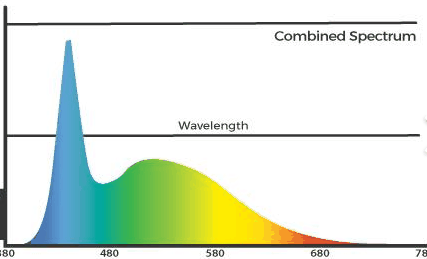
This is the spectrum of one popular LED set up for aquariums. The effect on colors is:
| Item | Effect on color seen or photographed |
| Electric blue fryeri | bright |
| Green Plants | good |
| Yellow Labidochromis | good |
| Orange Goldfish | dull |
| Dragon Blood Peacock | dull |
This is not a good spectra for much of anything. It will give a blue tint to everything and it won’t grow plants very well. But it illustrates the pitfalls inherent in buying aquarium lights.
.
Spectra of Another Aquarium LED Light
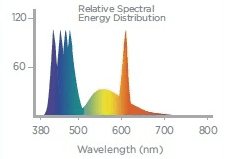
This is the spectrum of a 60% white, 20% blue and 20% red LED used in an aquarium. The effect on colors is:
| Item | Effect on color seen or photographed |
| Electric blue fryeri | brilliant |
| Green Plants | dull |
| Yellow Labidochromis | good |
| Orange Goldfish | bright |
| Dragon Blood Peacock | bright |
This is the best light for a typical aquarium (including mixed plant and fish aquariums) and can be achieved with most moderately priced aquarium LEDS.
.
Spectra of a Reef Aquarium LED Light
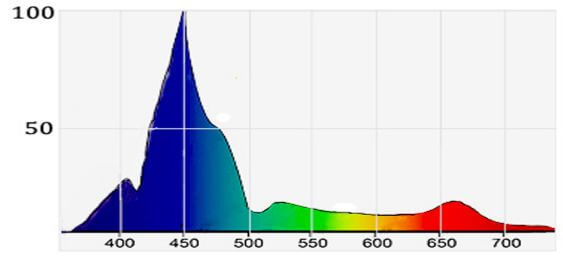
This is the spectrum of reef aquarium LED light. The effect on colors is:
| Item | Effect on color seen or photographed |
| Electric blue fryeri | brilliant |
| Green Plants | dull |
| Yellow Labidochromis | dull |
| Orange Goldfish | dull |
| Dragon Blood Peacock | dull |
Many freshwater hobbyists get these by mistake. You can tell when they put their photos up on social media. They all have a distinct blue tinge.
.
LED Aquarium Grow Light Spectra
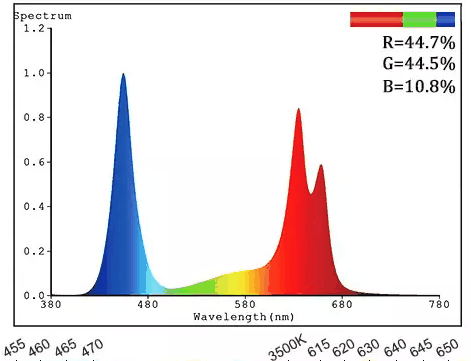
This is the spectrum of a LED grow light for a planted aquarium. The effect on colors is:
| Item | Effect on color seen or photographed |
| Electric blue fryeri | brilliant |
| Green Plants | dull |
| Yellow Labidochromis | dull |
| Orange Goldfish | dull |
| Dragon Blood Peacock | brilliant |
Now this is the strongly violet tinged light seen in advertisements for grow lights. These are the best lights for growing plants. This can be seen by looking at the absorption spectra for a green plant:

Plants absorb light only in the blue and the crimson red area of the spectrum if the light is low to moderate. Some plants can absorb energy in the orange, green and scarlet portions of the spectrum if the light is VERY strong. Blue light combines with crimson light to give violet light. Therefore grow lights are violet tinged.
.
Return to Equipment Menu
.
Aquarium Science Website
The chapters shown below or on the right side in maroon lead to close to 400 articles on all aspects of keeping a freshwater aquarium. These articles have NO links to profit making sites and are thus unbiased in their recommendations, unlike all the for-profit sites you will find with Google. Bookmark and browse!
.

Dave says
In reply to image guy … It is the correct spectrum for a Growlight (designed purely to grow plants)
Image Guy says
Is this correct?
https://imgur.com/a/hHtqqbA
Dave says
In reply to Lloyd ….. The lights from your greenhouse will work just fine And I haven’t reviewed LED plant lights in depth so I can’t recommend a brand. But the new Aquarium Coop lights are getting some very good feedback.
LLoyd says
Hello Dave, I have extra LED grow light from growing pepper from my green house, They are Spider SF 1000 and Atreum Hydra 1000. They are dimmable also.
Can I use them for my planted aquarium. I have CO2 set up also. So, I can transfer it by getting a diffuser.
If it LED grow light are good which one did you recommended for my tank.
Thanks
LL
Dave says
In reply to Ben G …. Good catch. That is an error that was on the spectrum when I captured it so there isn’t much I can do about it without a whole lot of hassle.
Ben G says
For “LED Aquarium Grow Light Spectra” did you mean 44.5 % for blue instead of green?